|
ASSYRIA |
|---|

Seen from a motion picture
MESOPOTAMIA and ASSYRIA -- 3,000 BC
Although primitive forms of picture or character writing first started appearing around 4,000 BC, it was the Sumerians (Mesopotamia or southern Iraq) that seem to be the first ones to have developed a practical form of writing that today is known as Cuneiform at or around 3,000 BC. And while pictographs (using pictures to portray whole words or concepts) were in use long before that, Cuneiform writing provided a means of recording specifics. Thus it can be said that written history began at that time.
And one of the reasons that we know that Medical Cannabis was well in use lomg before written history is because so many civilizations (as soon as they obtain a written language), speak of it in their writings, in the past tense, as if it had already been in use for many hundreds of years before then.
ABOUT CUNEIFORM
In order to continue, we first have to have a basic knowledge of Cuneiform. As can be seen by the table below, like many other forms of writing, it too seemed to start out as a series of basic pictographs. One in which each character equates to one word, but soon became (what is believed to be) earth's first written language.
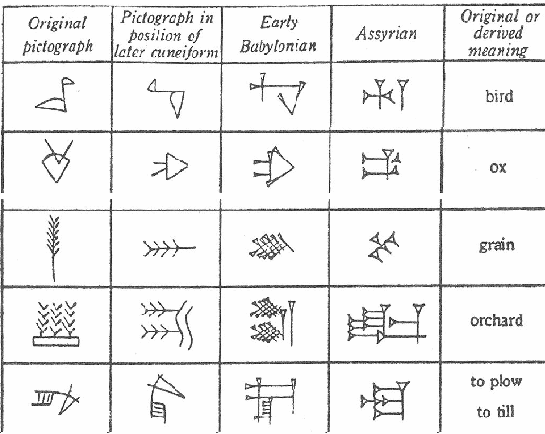
From Simple Pictographs to Syllabic Alphabet [1]
THE BASIC MECHANICS OF CUNEIFORM:
In order to simplify things; --- imagine yourself in a place without paper --- plenty of mud and water, but no paper. This kind of helps explain the very nature of cuneiform writing; literally wedge shapes on clay tablets. One can almost see how natural it would have been for a scribe to have simply taken a cut reed (many water reeds have naturally wedge-shaped stocks) and used it to imprint the delta-wedge unto the soft clay.
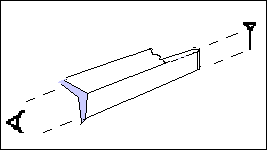
Cut Water Reed
The same reed could also have had a sharpened edge at the other end to imprint lines as well. Afterwards, the clay tablets themselves would be hardened by either baking them or simply allowing them to be dried in the hot sun for preservation. [Granted, not as good as paper, but better than nothing]
SYLLABLES VERSES ALPHABETS:
Unlike our alphabet which is built up around individual sounds (one sound, equals one character), cuneiform is built up around complete syllables. Let us use the Sumerian word for Medical Marihuana A.ZAL.LA as a good example:
The sound “Ah” in English = “A”; in Cuneiform =Thus Azalla =
The sound “Zal” in English = “zal”; in Cuneiform =
The sound “La” in English = “la”; in Cuneiform =



Note that using an alphabet we need to use 6 character letters [azalla], while in cuneiform (which is built up around complete syllables) only 3 character letters are needed. Now let's look at a second example, the Assyrian word for Medical Marihuana. A.ZAL.LU
The sound “Ah” in English = “A”; in Cuneiform =Thus Azallu =
The sound “Zal” in English = “zal”; in Cuneiform =
The sound “Lu” in English = “lu”; in Cuneiform =



Once developed, syllabic cuneiform proved so popular that it quickly spread to . . . well just about everywhere else in the area. And why shouldn’t it, while different languages have different sounds, the basic sound syllables stay the same. Thus almost any language group can adapt cuneiform with ease.
With reference to the two examples above -- notice that although we are dealing with two different languages, because the sounds are so similar the cuneiform characters used to write the word are also very similar. Ok, one last example. Somewhere around the middle of the 7th Century BC, the Assyrian word for Cannabis changed from Azallu to QU.NU.BU
The sound “Qu or Ku” in English = “qu”; in Cuneiform =Thus Qunubu =
The sound “Nnu” in English = “nu”; in Cuneiform =
The sound “Bu” in English = “bu”; in Cuneiform =

Here note that we are dealing with a completely different sound pattern and thus the syllable symbols, needed to represent the word would obviously be different. However, this brings about an obvious question -- Why the Change? Answer - no one seems to really know. However, note how close its sound pattern is to the ancient Greek word for Cannabis.

Which in turn is the source-word for our present-day word Cannabis, thus making it one of the oldest words still in use today.
MODERN ENGLISH --- AND PROBLEMS WITH CUNEIFORM:
Today cuneiform writing presents us with two major problems.
First, just like in English, cuneiform seems to have had multiple letters that stood for what to our ears are essentially the same sounds. For example, in English the “F” sound can be represented using three different letter patters:
So too in Ancient Mesopotamian, the same sound could be represented differently. For example, the sound pattern “La” can actually be written using three different cuneiform letters:
 LÁ |
 la |
 nu or là |
 lu |
 lu |
 lú |
Tablet K10507 denotes Medical Cannabis [a.zal.la] as

While tablet K4023 spells Medical Cannabis [a.zal.la] as

So which is right, which is wrong? Probably both (with my spelling problems, I should speak), again just be aware that different spellings exist.
 More About Cuneiform More About Cuneiform
|
|---|
The second problem with cuneiform is that the ancient Sumerians didn’t seem to speak English very well. And because its been quite a while since any native speakers of Sumerian have been around we are now presented with some translational problems, which obviously have created some disagreements on the subject.
But before going into this subject, let's look at some actual clay tablets:
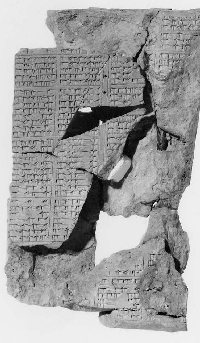
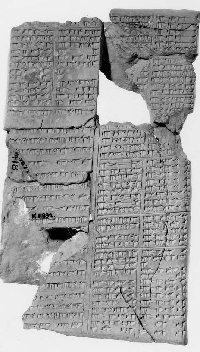
British Museum of London - K.4345 (front side) ID Code PS-186719
British Museum of London - K.4345 (back side) ID Code PS-186720
Probably the most famous Assyrian medical tablets known. For whatever reason, everyone likes to point to this one. Even the British Museum’s own website (which normally is silent about these kind of things) states as follows:
Title (series)
Library of Ashurbanipal
Description -- Part of a clay tablet, lexical list of plants, 28 + 7 lines of inscription, Neo-Assyrian. Includes reference to cannabis (hemp), Assyrian azallu [2]
Dimensions - Length: 13.33 centimetres - Width: 9.84 centimetres - Thickness: 2.22 centimetres
|
|
|---|
Assyrian Medical Tablet K3201
K.3201 = AM-87 #5 Line 15
AM-87 [K.3201] Line 15 = AM-87 #5
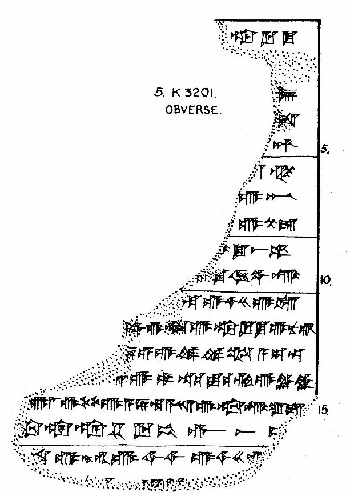
[K.3201 = AM-87 #5 Line 15]
No. 236. AM, 87, 5 (K. 3201)
OBVERSE

[AM-87 #5 Line 15 ]
Assyrian Medical Tablet K2615
K.2615 = Line 4 AM-01 #4
AM-01 #4 = [K.2615] Line 4

[K.2615 = Line 4 AM-01 #4]
Tablet K.2615 [Plate AM-1 No. #4]
REVERSE
[Next Line 5]

[AM-01 #4 = [K.2615] Line 4]
Assyrian Medical Tablet K6261
K.6261 = AM-89 Line 5
AM-89 #1 = line 5 (K.6261)
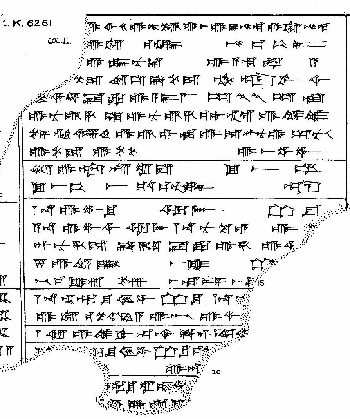
[K.6261 = AM-89 Line 5]
Tablet K.6261 [Plate AM-89 No. #1]
REVERSE COL. II
[Next Line 9]

[AM-89 #1 = line 5 (K.6261)]
Assyrian Medical Tablet K8127 + 8439
K.8127 AM, 90, 1 (K.8127 + 8438)
K.8438 AM, 90, 1 (K.8127 + 8438)
AM-90 #1 (K.8127 + 8438) Line 20

[K.8438 AM, 90, 1 (K.8127 + 8438)]
Tablet Tablet K.8127+8439 [Plate AM-90 No. #1]
REVERSE COL. III

[AM-90 #1 (K.8127 + 8438) Line 20]
Assyrian Medical Tablet K2974
K.2974 = Line 7 - AM-14
AM-14 #5 = [K.2974] = Has Line 7
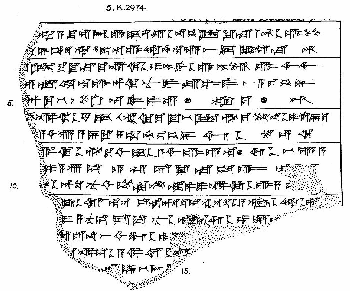
[K.2974 = Line 7 - AM-14]
Tablet Tablet K.2974 [Plate AM-14 No. #5]
COL. I
[Next Section] Line 41

[AM-14 #5 = [K.2974] = Has Line 7]
Assyrian Medical Tablet K4023
K.4023 = Line 39 AM102
AM 102 #1 = Line 39 [K.2566 + 10475: K.4023: K.7642 : K.7884: K.8090] K.4023 Line 39
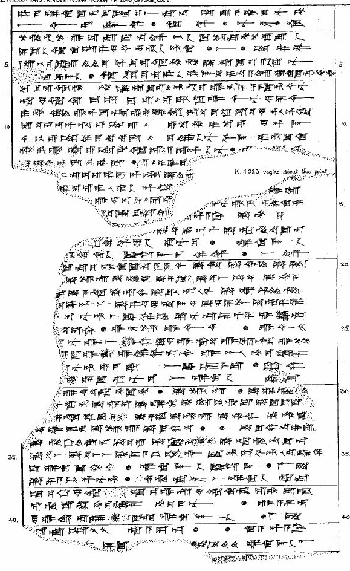
K.4023 = Line 39 AM102
Tablet K.4023 [Plate AM-102]
COL. I

[K.4023 = Line 39 AM102]
Assyrian Magical/Medical Tablet K10507
K.10507 = Line #3 AM-66 #4 Line 3
AM-66 #4 [K.10507] Line #3
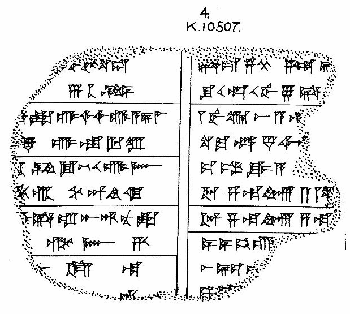
K.10507 = Line #3 AM-66 #4 Line 3
Tablet Tablet K.10507 [Plate AM-66 No. #4]
COL. I
1 . . . . six times thou shalt plait (twist).
3. . . . garlic(?), *calendula, cannabis . . . seven drugs for plaiting
5. . . . ten(?) drugs . . . (this is from a copy from Assyria).
7. . . . a seal of balti-stone not inscribed . . . will remove (?)
[Next Section] Line 8

[AM-66 #4 [K.10507] Line #3]
A DICTIONARY OF ASSYRIAN CHEMISTRY AND GEOLOGY
By R. Campbell Thompson
Assyrian Botany
The Assyrian Herbal, as we know it from the botanical lists and the medical prescriptions of the Royal Library at Nineveh, contains more than four hundred Sumerian names or expressions for plants, trees, and the like, and nearly twice as many Semitic equivalents for these. In medicine more than a hundred of these were in common or fairly common use as drugs. Perhaps a hundred and fifty more, which were less popular, may be synonyms of the first hundred. A large proportion of these have been identified with their modern equivalents. These are drawn up in the plant-lists in double columns (the usual method in these syllabaries) which are subdivided into paragraphs or registers by cross-lines, the contents of each register relating either to one particular plant, or to similar plants connected with each other for some reason by the scribe. The arrangement of the order is peculiar, the botanists beginning, for instance, with grass, . . . .
 MORE |
|---|
ABOUT THE WORD:
Just like in the English Language where we have many words like Hemp, Cannabis, Marihuana etc., to describe one plant, so to did the ancient Assyrians. R. Campbell Thompson in his 1936 "A Dictionary of Assyrian Chemistry and Geology," gives the two following Assyrian words:
In addition Thompson goes on to point out various sub-meanings of the words; i.e. [In A-ZAL-LA the 'ZAL' part means to "SPIN," such as in, the plant that can be used for the spinning of cloth. As well as the similarity of these words [in our case specifically Cannabis] in other languages.AZALLUU (A-ZAL-LU-U) [Related word A-Xal-Lu-u - meaning the plant used in spinning and is very close to the Sumerian or Babylonian word - A-ZAL-LA]
GURGURRU (GUR-GUR-RU) [Related word Gur-Gur-Rum - meaning a ship's cable or rope of hemp)]AZALLA (A-ZAL-LA)
SAMINIISSATI (SA-MI-NI-IS-SA-TI)
GANZIGUNNU (GAN-ZI-GUN-NU)
HARMUUM (HAR-MU-UM)
HARGUD (HAR-GUD)
But again, the exact meaning of these words is still somewhat open to interpretation, and the argument can be made that all of these references refer only to (what is now known as) "Industrial Hemp" and not Medical Cannabis per say. However such an argument begs the following question; Why would references to ropes or cloth, be made mention of in what are otherwise medical texts?

Chemistry and Geology |
|---|
The Royal Library of Ashurbanipal:
Why we know so much about Assyrian Medicine?
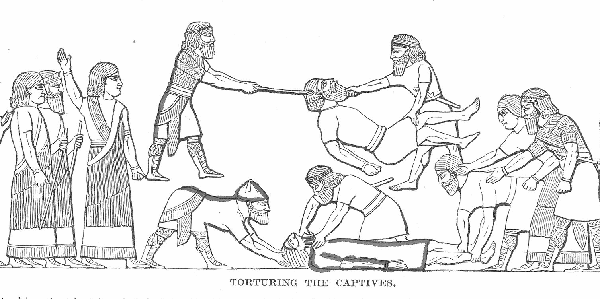
To my eye, the above relief shows members of ancient Assyria’s drug police. No doubt they just made a raid on a hospital, dragging off cancer victims that needed to make use of Medical Cannabis. The guy on the left with the hail-Hitler salute, is obviously their Drug Czar, while the two on the left represent members of the Nation Drug Enforcement Industries (big bucks in it, even back then), rooting them on.
Ok, ok, maybe that is a bit far fetched, but how do we know that any other story is any better. Answer: because the Assyrians had a written language, allowing them to write down exactly what was happening. However, the present day reader should be warned or at least aware of the following:
“Our knowledge of the medicine of the Babylonians and Assyrians is derived almost exclusively from the great library of clay tablets gathered in his palace by King Ashurbanapal of Assyria, who ruled from 668 to 626 B.C., and which was discovered by Sir Austen Henry Layard in 1849 in the course of his excavations at the Mt. Kouyunjik, opposite Mosul, the site of Nineveh, which was the capital of the later Assyrian Empire. About 30,000 fragments of the clay tablets of the collection, which may well have numbered over 100,000 when complete, . . “ --- Medicine of the Babylonians and Assyrians By Morris Jastrow (1913)Which means that about 80% of what we know about ancient Mesopotamia comes solely from one source, the Library of Ashurbanapal [aka the library of Kouyunjik], which contained around 650 medical tablets. Thus this brings up an obvious question --- what if this one source had a hidden agenda? What if they had censored some things, but not others?
This issue can be addressed as follows:
- First, it is well acknowledged that the library of Kouynjik, for the most part was not made up of original works, but actually a collection of reproductions from other sources. Meaning someone else had the originals. Example, note that references are made to Azalla, Azallu, Qunubu etc., under various spellings. Obviously this is because the originals (some going back thousands of years before being copied) made reference to Medical Cannabis that way.
- Next, for whatever reasons, medical textbooks have a way of escaping destruction. Even the evil Narc’s today have not seen fit to destroy all historical evidence of the use of Medical Cannabis.
- Then there is the fact that other sources also exist; example, the following is taken from, “The Nimrod Tablets”, 1950 Author(s): D. J. Wiseman and J. V. Kinnier Wilson [3]
"If a man .... its taltallu you shall cut off, in the . . . for 10 days the waters (juice) of taltallu 2 (part of a palm-tree) you shall drink . . . oil, the gum of the taltallu .... 4 days each Cannabis .... 5 /6 mana of myrrh . . . twice 10 shekels from the land of Carchemish . . . you shall beat it out . . . you shall press it out . . . . " Text (needs further checking) :?2nd Example (non-Medical) from The Royal Correspondence at Kouyounjik, Letter 368 (p. 381) pertains to the performance of a religious observances undertaken in the court of King Esarhaddon
(1) [fum-ma] am elu. (2) . . . . az a-na ni[? . . .]ru. (3) .... (is)tal-tal-li-fu .... (4).. . . su ta-ba-ra-as ina . . . (mes). (5). . . . a-na io u^-me-fu me(mes) sa (is) tal-[tal-] li. (6) . . . . e-bit-?-II samni(mes) riqqu istu (is) tal-tal (?)-li-su. (7). . . . ina di-ki-lat mat a-di bit i-?- SAL.NUN.ni ... (8) .... 4 urne (riq) gu-nu-bu al(?) Kal-bu ina muh-hi ta-za-am. (9) . . . ri-si parap ma-na riq SES ta-ma-sal. (10) . . . ta-ga-mar a-na su ta-bat- tak. (11) .... kar-ra-sr-di io siqli(mes) ? sa (mat) Gar-ga-mis. (12) ... . ta-ma-sal a-na z-su-ma ta-bat-tak. (13) . . . ta-kar-ra-dr i-bi-ia da . . (14) .... 2 e-si-su ta-za- ha-at tu-ul-? ....
 |
|---|

In the 1930's America's drug police began a massive dis-information campaign against the use of Medical Cannabis. And while, this website is NOT an appropriate forum to discuss either Reefer Madness or the origin of the anti-Medical Marihuana laws. One however, cannot ignore the fact that the narc's (through verbal slight of hand) have from the very beginning distorted historical facts, even ancient ones to fit their needs. Thus one can easily imagine what a field day they must have had with the following translation of the word Cannabis: "The drug that takes away the pain, but also robs the user of his soul"However, this (only one of many) interpretation fails to take into account the fact that around 50% of all Sumerian medial texts consisted of magical spells, or incantations, to drive away the evil demons that were thought to be the cause of illness. [A belief that held up well past biblical times; i.g. Jesus was said to have cured the ill, by casting out demons etc.] Thus a more accurate interpretation should be: "Medical Cannabis - The drug that takes away the pain, as well as the evil spirit afflicting the victim"or if one prefers: "Medical Cannabis - The medicine that takes away the pain as well as drives away the evil demons"Because no one today can really speak ancient Sumerian (everyone, including the experts are just taking guesses), one can accept any of the above interpretations (which obviously depend on ones political viewpoint) as being the correct interpretation. Once more this website is NOT an appropriate place to discuss Reefer Madness. The only point being made here is that the narc's have a way of telling only parts of the truth --- those parts of the truth that they particularly want you to know. Please keep in mind that there are OTHER interpretations. |
|---|
FOOTNOTES:
[1]- From the book “They Wrote on Clay” by Edward Chiera
[2]- The actual word written on the tablet is a-zal-la, not a-zal-lu?
[3]- “The Nimrud Tablets”, 1950 Author(s): D. J. Wiseman and J. V. Kinnier Wilson Source: Iraq, Vol. 13, No. 2 (Autumn, 1951), pp. 102-122 Published by: British Institute for the Study of Iraq
WORKS OF INTEREST:
Harper, Robert Francis , ‘Assyrian and Babylonian letters belonging to the Kouyunjik collections of the British museum’, University of Chicago, Chicago, 1896, p. 381.
L.Waterman, ‘Royal Correspondence of the Assyrian Empire’ 1936,p.257.
1908 Assyrian Medical Texts, London
Astral Magic in Babylonia By Erica Reiner - Article “Transactions of the American Philosophical Society,” New Ser., Vol. 85, No. 4. (1995), pp. i-xiii+1-150.
1923 The Assyrian Herbal, London
1924 On the Chemistry of the Ancient Assyrians,
A Dictionary of Assyrian Chemistry and Geology, Oxford 1936
A Dictionary of Assyrian Botany, London 1949 by Thompson, R.C.
"Assyrian Prescriptions for Treating Bruises or Swellings" By R. Campbell Thompson. The American Journal of Semitic Languages and Literatures, Vol. 47, No. 1. (Oct., 1930), pp. 1-25.
Our thanks to the "British Museum of London" for providing us with pictures of the Assyrian Clay tablet shown above --- http://www.britishmuseum.org
British Museum Nomenclature:
K = Kouyunjik , referencing those tablets found in the library at Kouyunjik
CT = Cuneiform Texts from Babylonian Tablets, etc., in the British Museum. London, 1896--
AM = Assyrian Medical (tablets)
ND = Nimrud Tablets
KMI = Keils. Medizin. Inhalts by Herr Ebeling
PRSM = Journal, Proceedings of the Royal Society of Medicine
Babyloniaca = A Franch language
ZA = Zeitschrift fur Assyriologie und uenoandte Gebiete, Leipzig, 1886-
WANT TO KNOW MORE:
=====================
Due to space / download time considerations, only selected materials are displayed. If you would like to obtain more information, feel free to contact the museum. All our material is available (at cost) on CD-Rom format.
CONTACT PAGE
ASSYRIA Back to the Last Section |
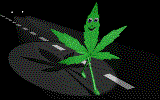 BACK TO CHAPTER 2 |
ASSYRIA On to the Next Section |